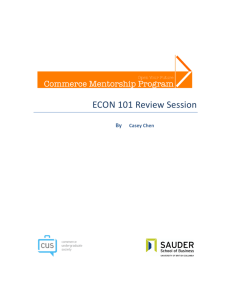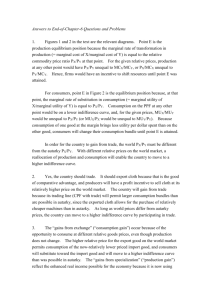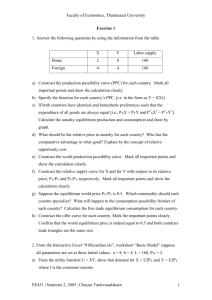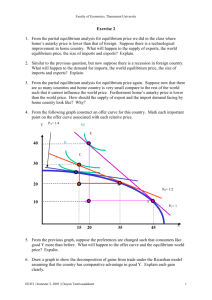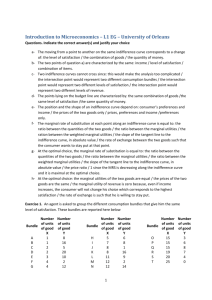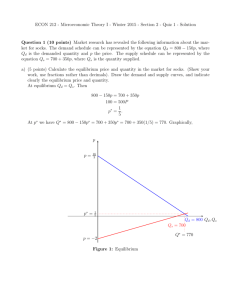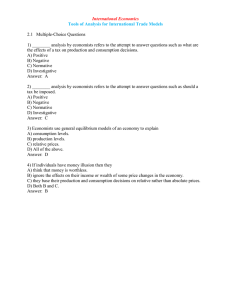Trade slides (Neo Classical)
advertisement
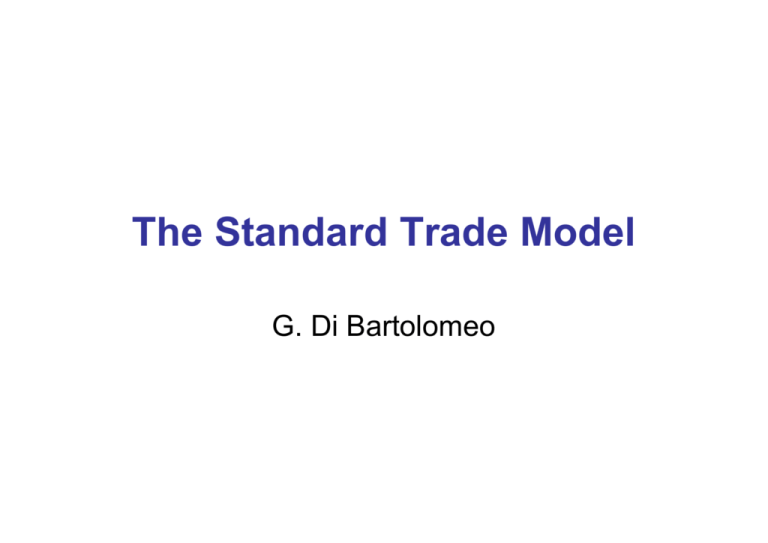
The Standard Trade Model G. Di Bartolomeo Increasing opportunity costs • Increasing amounts of another item must be given up in order to release sufficient resources to produce one more unit of a given item. • What leads to increasing opportunity costs? – Non-homogenous factors of production – Factors that are not used at constant fixed proportions in production The production possibility frontier Y • The marginal rate of transformation (MRT) increases as more units of good X are produced. X – The marginal rate of transformation is another name for opportunity cost. – The value of MRT is given by the slope of the PPF. Community indifference curves • A community indifference curve displays the combinations of two products that offer the community the same level of satisfaction. • Characteristics of community indifference curves – Negative slope – Convex to the origin – Different curves do not cross A community indifference curve map Y III II I X • The marginal rate of substitution (MRS) falls as more of good X is consumed. – The MRS is the amount of one commodity that must be given up as one gains additional units of another commodity. The autarky equilibrium • Autarky exists in the absence of international trade. • The autarky equilibrium occurs when maximum societal satisfaction has been obtain from available production. • This will occur when one community indifference curve is tangent to the PPF. Y III II I X The autarky equilibrium • For the indicated case, the equilibrium occurs at the tangency of community indifference curve II and the PPF. • Given the convex, downward sloping, and non-intersecting nature of community indifference curves, only one such tangency will exist. Y III II I X Relative prices • The equilibrium relative commodity price in isolation (or autarky) is given by the slope of the tangent. • The slope of this tangent is Px/PY or the price of good X divided by the price of good Y. • This slope also gives the opportunity cost of producing X in terms of foregone units of Y. Y X Trade in the standard model Y • Trade in the standard model is driven by differences in the opportunity costs of production. • Opportunity cost may be determined by the slope of the tangency at the autarky equilibrium point. Nation 1 X Y Nation 2 X Trade in the standard model • In this case, the slope of the tangent for Nation 2 is less (in absolute terms) so the opportunity cost of producing X in Nation 2 is less than the opportunity cost of producing X in Nation 1. • In other words, Nation 2 has a comparative advantage in the production of X. Y Nation 1 X Y Nation 2 X Trade in the standard model • The comparative advantage of Nation 2 in X will lead it to produce more of X. • Similarly, since Nation 1 must have a comparative advantage in Y it will produce more of Y once it begins to specialize and trade. Y Nation 1 X Y Nation 2 X Trade in the standard model • The movement of production and trade will move production from point A (see the following slide) to point B in both countries. • At the new production point, both countries will be able to trade to a final consumption point on a higher community indifference curve than the original curve (point C). Trade in the standard model Y Nation 1 Y Nation 2 B A A B X X Trade in the standard model Y Nation 1 Y Nation 2 C B A A C B X X Trade in the standard model • The movement of production and trade will move production from point A (see the following slide) to point B in both countries. • At the new production point, both countries will be able to trade to a final consumption point on a higher community indifference curve than the original curve (point C). • At point C, Nation 1’s exports of Y Trade in the standard model Y Nation 1 Y Nation 2 C B A A C B X X Trade in the standard model • The movement of production and trade will move production from point A (see the following slide) to point B in both countries. • At the new production point, both countries will be able to trade to a final consumption point on a higher community indifference curve than the original curve (point C). • At point C, Nation 1’s exports of Y are matched by Nation 2’s imports of Y. Trade in the standard model Y Nation 1 Y Nation 2 C B A A C B X X Trade in the standard model • The movement of production and trade will move production from point A (see the following slide) to point B in both countries. • At the new production point, both countries will be able to trade to a final consumption point on a higher community indifference curve than the original curve (point C). • At point C, Nation 1’s exports of Y are matched by Nation 2’s imports of Y. • At the same time, Nation 2’s exports of X Trade in the standard model Y Nation 1 Y Nation 2 C B A A C B X X Trade in the standard model • The movement of production and trade will move production from point A (see the following slide) to point B in both countries. • At the new production point, both countries will be able to trade to a final consumption point on a higher community indifference curve than the original curve (point C). • At point C, Nation 1’s exports of Y are matched by Nation 2’s imports of Y. • At the same time, Nation 2’s exports of X are matched by Nation 1’s imports of X. Trade in the standard model Y Nation 1 Y Nation 2 C B A A C B X X Two important points • At the final production points (B) and consumption points (C), the marginal rates of transformation and marginal rates of substitution are the same in both economies. – This entails that relative prices in both nations are the same after trade. Two important points • At the final production points (B) and consumption points (C), the marginal rates of transformation and marginal rates of substitution are the same in both economies. • Neither country completely specializes in the production of X or Y. – Complete specialization is an outgrowth of constant opportunity costs. – Since constant opportunity costs do not hold, complete specialization is unlikely to be seen. The terms of trade • The relative price of X and Y determine the terms of trade in a two country, two commodity setting. • The terms of trade is the ratio of the index price of a nation’s exports to the index price of its imports. • An improvement in a country’s terms of trade are typically viewed as beneficial. – An improvement in the terms of trade indicates that fewer export goods will need to be provided to purchase the same number of import goods. The terms of trade • The relative price of X and Y determine the terms of trade in a two country, two commodity setting. – For Nation 1 in the previous example, PY/Px was its terms of trade. – For Nation 2 in the previous example, Px/PY was its terms of trade. Changing the employment mix • The examples of trade demonstrate that specialization and trade will result in job losses in some sectors, but job gains in others. • Does this mean a loss of manufacturing jobs? – It depends on a nation’s comparative advantage – The experience of recent years points to the comparative advantage of the “industrialized” nations residing in services. – Hence, the expected movement of employment would be from manufacturing to the service sector.

